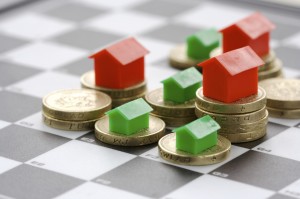Have you wondered how many investment properties you would need for financial freedom?
I’ve found that while most property investors hope to one day replace their personal exertion income with cash from their investment properties, most don’t have a strategy to achieve their goal.
So just how many properties does it take to enable you to quit your day job and live comfortably?
The answer is simple…
It depends.
O.K. that’s probably not what you wanted to hear, but in fact it’s a bad question.
It doesn’t really matter how many properties you own.
What is more important is the value of your asset base and how hard your money works for you.
Why do I say this?
Because I’d rather own one Westfield Shopping Centre than 50 secondary properties in regional Australia.
How will you live off your property portfolio? 
While many property investors know they want their properties to replace their income, I’ve found most don’t actually think about how they’ll actually achieve financial freedom.
They don’t have a strategy.
They don’t have a plan.
They just hope it will happen.
Other investors think that they’ll live off their rental income, yet I rarely see this happen.
It’s just too hard to grow a portfolio of cash flow positive properties of a sufficient size to replace your income.
On the other hand, the wealthy investors I deal with have built a cash machine by growing a substantial asset base of high growth properties, and then lowering their loan to value ratios (LVR) so they can transition into the next phase, the cash flow phase of their investment life.
They lower their LVR in a variety of ways.
They could:
- Stop (or slow down) buying properties, so that while the value of their portfolio keeps rising, their loans remain much the same.
- Add value to their properties by manufacturing capital growth through renovations or development;
- Pay off some debt using their superannuation;
- Reduce their debt by pay off principal and interest; or
- Sell a property or two.
But the first stage of their wealth creation strategy always involves building a substantial asset base.
Can’t I just live off the rent?
Let’s say you want an annual after tax income of $100,000.
How are you going to achieve that?
How many properties do you need?
If your plan is to eventually pay down your debt and live off the rent, you’ll probably need at least $4million worth of properties with no mortgage to achieve that $100,000 after tax income.
Don’t believe me?
The average gross yield for well located properties in Australia is around 4%, but let’s be generous and say you earn a 4.5% yield across your property portfolio.
This means if you eventually own $1 million worth of properties with no debt, you’ll get $45,000 rent. 
But you’ll still have to pay rates and taxes and agents commissions and repairs; leaving you with something like $35,000 a year.
And then you’ll have to pay tax on this income.
When you do the sums you’ll see that you need an unencumbered portfolio worth at least $4million to earn that $100,000 a year after tax.
Remember that’s $4 million worth of property and no mortgage debt, otherwise your cash flow will be lower.
And of course you’ll also need to own your own home with no debt against it.
Let me ask you a question…
Will you ever be able to save $4million?
Will you ever build a portfolio that size on a few dollars a week positive cash flow from your rents?
By now it should be clear that the only way to build a substantial asset base is to take advantage of leveraging and compounding growth of well located properties.
In my mind the only way to become financially independent through property is to first grow a substantial asset base (by buying high growth properties) and then transitioning to the next stage – the cash flow stage – by lowering your debt, but not paying it off completely.
Here’s how it works:
Fast forward 10 or 15 years and imagine you own your own home plus $5million of well located investment properties.
If you had a typical 80% Loan to Value Ratio, you would be negatively geared.
On the other hand, if you had no debt against your property portfolio you would have positive cash flow, but would forego the benefits of leverage.
Somewhere in the middle, maybe with a 50% LVR, your property portfolio would be self funding.
You may even have a little cash flow left over, but not enough to live on.
If you think about it, it will be much easier to amass a $5million property portfolio with $2.5 million of debt than the same size portfolio with no debt.
You could then go to the bank and explain you’ve got a self-funding portfolio that isn’t reliant on your income and in fact, there’s a little cash left over for serviceability.
You would then ask for an extra $100,000 loan, so you’re increasing your LVR slightly.
The good news is that you don’t have to pay tax on this money because it’s not income.
But you would have to pay interest, which won’t be tax deductible if you use the money for your living expenses.
This means after the interest payments you’re left with around $93,000 to live off.
Crunch the numbers…
At the end of the year, you’ve “eaten up” your $100,000; but in a good year, your $5 million property portfolio would increase in value by say $500,000.
In an average year it will have increased in value by $400,000 and in a bad year it may have only gone up by $150,000 or $200,000.
Of course your rents will also have increased because your properties have increased in value.
Sure you’ve used up the $100,000 you borrowed, but because your portfolio has risen in value, along with rents, your LVR is less at the end of the year than the beginning, so you finish off the year richer than you began it.
You truly have a cash machine, and then you can do this over and over again.
Does this really work?
In the old days living off equity was easy. 
You just had to go to the bank and get a low doc loan and as long as your properties increased in value it was smooth sailing.
Sure it’s harder today, but it’s definitely do-able.
You just have to lower your LVR to show serviceability to the banks.
Needless to say, you can’t achieve this overnight.
It takes time to build a substantial asset base and a comfortable loan-to-value ratio.
But if you take advantage of the magic of leverage, compounding and time, it happens.
Do you have an asset protection plan?
Of course this strategy depends on the growth in your property portfolio and your ability ride the property cycle. 
This means that as you build your asset base, buying high-growth properties and adding value, you will need an asset protection plan to see you through the ups and down that you’ll experience.
After all, over the next 10 years we’ll have good times and bad.
There will be periods of high interest rates and times of lower interest rates.
And we’ll have periods of strong economic growth, but there will also be downturns.
Savvy investors count on the good times but plan for the downturns by having an asset protection plan, as well as a finance and tax strategy to make sure they set up their structures in the most efficient way.
Don’t get me wrong, while I’ve just made gaining financial freedom from property investing sound simple, it’s not easy.
And that’s not a play on words.
The fact is, around 20% of those who get involved in property investment sell up in the first year and close to half sell their property in the first 5 years.
And of those investors who stay in property, about 90% never get past their second property.
So if you want financial freedom from property investment to fund your dreams, you’re going to have to do something different to what most property investors are doing.
You’re going to have to listen to different people to who most Australian property investors listen.
You’re going to need to set yourself some goals and follow a strategy that’s known, proven and trusted.
Then you grow your property investment businesses one property at a time.
Of course…you need to buy the right type of properties
One that has a level of scarcity, meaning they will be in continuous strong demand by owner occupiers (to keep pushing up the value) and tenants (to help subsidise your mortgage); in the right location (one that has outperformed the long term averages), at the right time in the property cycle (that would be now in many states) and for the right price.
To become a successful investor you will need to surround yourself with a team of independent and unbiased professional advisors (not sales people) – a team of people who are known, proven and trusted, so it is probably appropriate to remind you that in changing times like we are experiencing, no one can help you quite like the independent property investment strategists at Metropole.
If you’re looking at buying your next home or investment property here’s 3 ways we can help you:
Sure our property markets are improving, but correct property selection is even more important than ever, as only selected sectors of the market are likely to outperform.
Why not get the independent team of property strategists and buyers’ agents at Metropole to help level the playing field for you?
We help our clients grow, protect and pass on their wealth through a range of services including:
- Strategic property advice. – Allow us to build a Strategic Property Plan for you and your family. Planning is bringing the future into the present so you can do something about it now! Click here to learn more
- Buyer’s agency – As Australia’s most trusted buyers’ agents we’ve been involved in over $3Billion worth of transactions creating wealth for our clients and we can do the same for you. Our on the ground teams in Melbourne, Sydney and Brisbane bring you years of experience and perspective – that’s something money just can’t buy. We’ll help you find your next home or an investment grade property. Click here to learn how we can help you.
- Wealth Advisory – We can provide you with strategic tailored financial planning and wealth advice. Click here to learn more about we can help you.
from Property UpdateProperty Update https://propertyupdate.com.au/how-many-properties-do-you-need-to-retire/


No comments:
Post a Comment